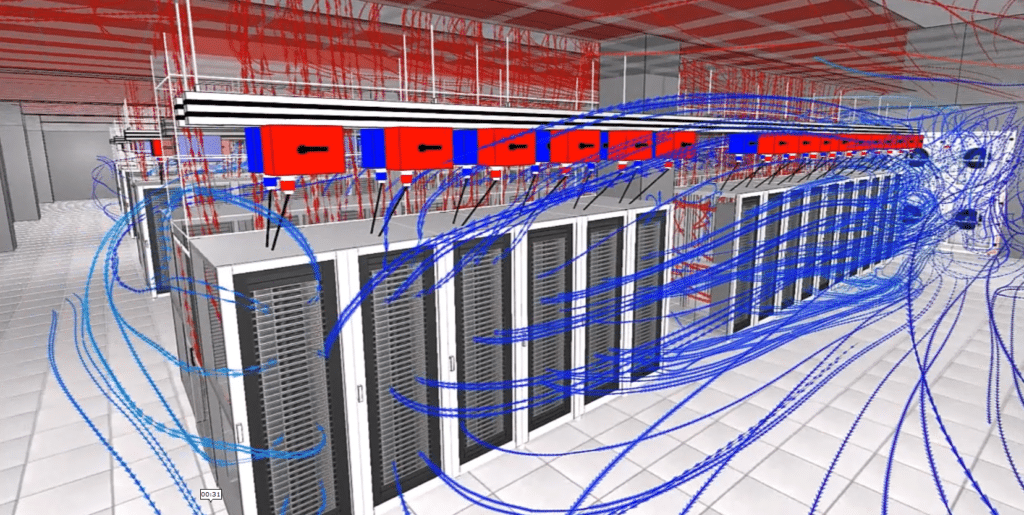Accueil » Data Center » CFD engineering for data centers » Cooling optimization – Data Center
Cooling optimization – Data Center
CFD analysis to optimize the cooling of a data center in Vénissieux, France
A study is carried out to analyze the temperature distribution in the attic where the climate control systems are located. Numerical simulations are carried out to identify potential problems and optimize the design of the air-conditioning system. The benefits of this optimization include improved energy efficiency, reduced operating costs and environmental impact, as well as increased reliability and longer equipment life.
CFD analysis to optimize the cooling of a Venissieux data center
Year
2024
Customer
CEME
Location
France
Typology
Data Center
Continue navigation :
- Data center audits and diagnostics
- CFD engineering for data centers
- Thermal study of technical premises
- Generators
- Designing your data center’s digital twin
- Urban heat island impact study for data centers
- External CFD simulation for data center
- Energy optimization and PUE calculation for data centers
- Data Center Fire Simulation
- Data center audits and diagnostics
- CFD engineering for data centers
- Thermal study of technical premises
- Generators
- Designing your data center’s digital twin
- Urban heat island impact study for data centers
- External CFD simulation for data center
- Energy optimization and PUE calculation for data centers
- Data Center Fire Simulation
Our other projects :
Latest news :
Technical file :
Our expertise:
Improving data center cooling: modeling thermal and aeraulic exchanges to ensure proper operation of IT equipment
Optimizing energy efficiency in data centers: temperature distribution study and technical solutions
In a large-scale data center environment, it is crucial to have cooling standards that meet the growing needs of the IT industry. As the density of IT equipment increases, the cooling of this equipment is a major concern for data centers. EOLIOS offers its expertise in modeling and understanding thermal and aeraulic exchanges in data centers. The aim of this assignment was to study the temperature distribution in the attic space where the climate control systems for 3 data halls are installed.
Current air-conditioning systems are inadequate, and overheating is a frequent problem in hot weather.
The study will propose technical solutions tooptimize energy efficiency and guarantee the smooth operation of IT equipment. More specifically, a CFD study willanalyze the temperature distribution around the heat rejection systems to determine whether heat rejection from the systems can contaminate the supply air by looping. Many factors come into play in this type of study, such as wall temperatures, wind pressure, internal resistance to airflow, openings in the building envelope, local terrain or the presence of mechanical systems stirring air around processes.
Preliminary analysis for numerical simulations
Site audit and 3D modeling
A technical audit of the site enables our engineers topinpoint the problem in question and its potential causes. To this end, numerous temperature and speed measurements are taken in the areas identified as crucial. This audit also enables us to propose a realistic 3D model of the site, including a precise description of the roof and all the blower systems present, taking into account the different models as well as their flow rates and dissipated power.
For greater accuracy, it will be necessary to model all the site’s external environment that could influence wind speeds and directions within a 100m radius.
Weather analysis
A study of local climatic conditions was carried out in order to obtain the maximum temperatures likely to be reached in summer in the coming years. In addition, average wind speeds and directions at the site, as well as the most unfavorable wind directions, were recorded. These parameters will be used to simulate worst-case scenarios in order to propose a robust solution at any time of year.
CFD study to analyze existing configuration
Why carry out a CFD study?
Computational Fluid Dynam ics, or CFD, brings together all the numerical methods used to study theflow of a fluid in a given environment. A CFD study is carried out as part of the study of a data center’s air-conditioning system to understandair flow, identify potential problems such as overheating or poor air circulation, optimize the design of the air-conditioning system and validate performance before commissioning the proposed modifications. This ensures optimal operation, increased reliability and energy efficiency of the data center.
Limitations of the current air-conditioning system design identified by the CFD study
The CFD study identified that the heat released by the air coolers is redirected by the wind towards the fresh air intake zones. This air looping phenomenon results in a temperature rise of almost 15° compared to outside air at intake level. Given the presence of these high-temperature zones at the intake end of the systems, the current design did not appear to be functional in the event of very hot weather for the wind directions prevailing at the site. These loops highlighted by the simulations resulted in cascading shutdowns of the climate control systems.
Upgrading existing data center cooling system
Technical solutions to limit air looping
In order to reducesystem intake temperatures, fresh air intake zones have been moved away from heat discharge zones to reduce recirculation. In addition, new air inlets are positioned on the roof, away from the discharge zone, toincrease the supply of outside-temperature air under the roof. Finally, theroof insulation has been increased to limit solar gain under the roof.
"Importance of the correct placement of ventilation openings: In-depth analysis of thermal and aeraulic exchanges for optimum efficiency"
These measures are designed to improve overall system performance by reducing the influence of warm exhaust air and limiting the intake of calorie-laden outside air, leading to a rise in temperature under the roof.
The results of this new design show a reduction in system intake temperatures. Simulations revealed that the new design reduced overall temperatures andachieved an inlet air temperature close to the outdoor temperature.
The benefits of optimizing data center cooling systems
The benefits of optimized cooling in data centers: energy efficiency and enhanced reliability
In conclusion,optimizing data center cooling systems has many benefits. Firstly, itimproves energy efficiency, thereby reducing operating costs andenvironmental impact.
In addition, these improvements ensure greater reliability by preventing problems associated with overheating, and extend equipment life. By maintaining the right temperature conditions,premature component wear is reduced, and failures due to extreme temperatures are avoided.
A controlled temperatures and and humidity regulation of servers, storage cabinets and other devices, ensuring maximum efficiency. maximum efficiency. This is an essential investment to ensure optimal data center operation while reducing energy costs.
Continue on this topic
- Data center audits and diagnostics
- CFD engineering for data centers
- Thermal study of technical premises
- Generators
- Designing your data center’s digital twin
- Urban heat island impact study for data centers
- External CFD simulation for data center
- Energy optimization and PUE calculation for data centers
- Data Center Fire Simulation
- Data center audits and diagnostics
- CFD engineering for data centers
- Thermal study of technical premises
- Generators
- Designing your data center’s digital twin
- Urban heat island impact study for data centers
- External CFD simulation for data center
- Energy optimization and PUE calculation for data centers
- Data Center Fire Simulation
Video summary of the study
Summary of the study
Objective:
Carry out a CFD analysis to optimize the cooling of a data center located in Vénissieux, France, and guarantee the smooth running of IT equipment.
Methodology:
-
Preliminary study:
- Site audit: Data center physical data (dimensions, rack layout, etc.)
- 3D modeling: Creation of an accurate digital model of the data center
- Meteorological analysis: Taking into account local climatic conditions (temperature, humidity, etc.).
-
CFD simulations:
- Simulations of airflow and heat transfer in the data center
- Analysis of airflow and thermal conditions (temperature, air speed, etc.)
- Identification of critical areas (overheating, poor air circulation)
-
Recommendations:
- Proposal of technical solutions to optimize the placement of ventilation systems
- Improving data center energy efficiency
- Lower operating costs
Video summary of the study - study of thermo-aerodynamic recirculation in a data center
Discover other projects
External & internal CFD – Data Center Hyperscale
CFD Optimization – Data Center
Data Center – DC28 – Internal
Pressure loss study – Generator – Data center
Data Center – PA 22 – External
Technical premises – Data Center
Cooling optimization – Data Center
Data Centers – DC15.1 & DC15.2 – External
Data Center – Paris
Data Center – GAZ NOVEC
CFD-Data Center – Saint Denis
Data center – DC25 – Internal
Data center – DC17 – Internal
Data Center – DC10 – Internal
Data center – DC25 & DC26 – External
Data center – D14 – External
Data center – DC17 – External
DC23 – External










